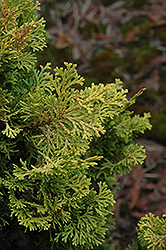It's all about ...
plants

Meroke Twin Hinoki Falsecypress
Chamaecyparis obtusa 'Meroke Twin'
Height: 6 feet
Spread: 32 inches
Sunlight:
![]()
![]()
Hardiness Zone: 4a
Description:
Bright gold variegated foliage becomes more intense in winter months; an upright, narrow habit of growth makes it a perfect choice as a residential landscape accent, along the back of borders; or for screening
Ornamental Features
Meroke Twin Hinoki Falsecypress is a dwarf conifer which is primarily valued in the landscape or garden for its ornamental upright and spreading habit of growth. It has attractive green-variegated gold foliage. The twisted scale-like sprays of foliage are highly ornamental and remain gold throughout the winter.
Landscape Attributes
Meroke Twin Hinoki Falsecypress is a dense multi-stemmed evergreen shrub with an upright spreading habit of growth. Its average texture blends into the landscape, but can be balanced by one or two finer or coarser trees or shrubs for an effective composition.
This is a relatively low maintenance shrub. When pruning is necessary, it is recommended to only trim back the new growth of the current season, other than to remove any dieback. It has no significant negative characteristics.
Meroke Twin Hinoki Falsecypress is recommended for the following landscape applications;
- Accent
- Hedges/Screening
- General Garden Use
Planting & Growing
Meroke Twin Hinoki Falsecypress will grow to be about 6 feet tall at maturity, with a spread of 32 inches. It has a low canopy with a typical clearance of 1 foot from the ground, and is suitable for planting under power lines. It grows at a slow rate, and under ideal conditions can be expected to live for 70 years or more.
This shrub does best in full sun to partial shade. It prefers to grow in average to moist conditions, and shouldn't be allowed to dry out. It is not particular as to soil type or pH. It is highly tolerant of urban pollution and will even thrive in inner city environments, and will benefit from being planted in a relatively sheltered location. Consider applying a thick mulch around the root zone in winter to protect it in exposed locations or colder microclimates. This is a selected variety of a species not originally from North America.
This plant is not reliably hardy in our region, and certain restrictions may apply; contact the store for more information.
